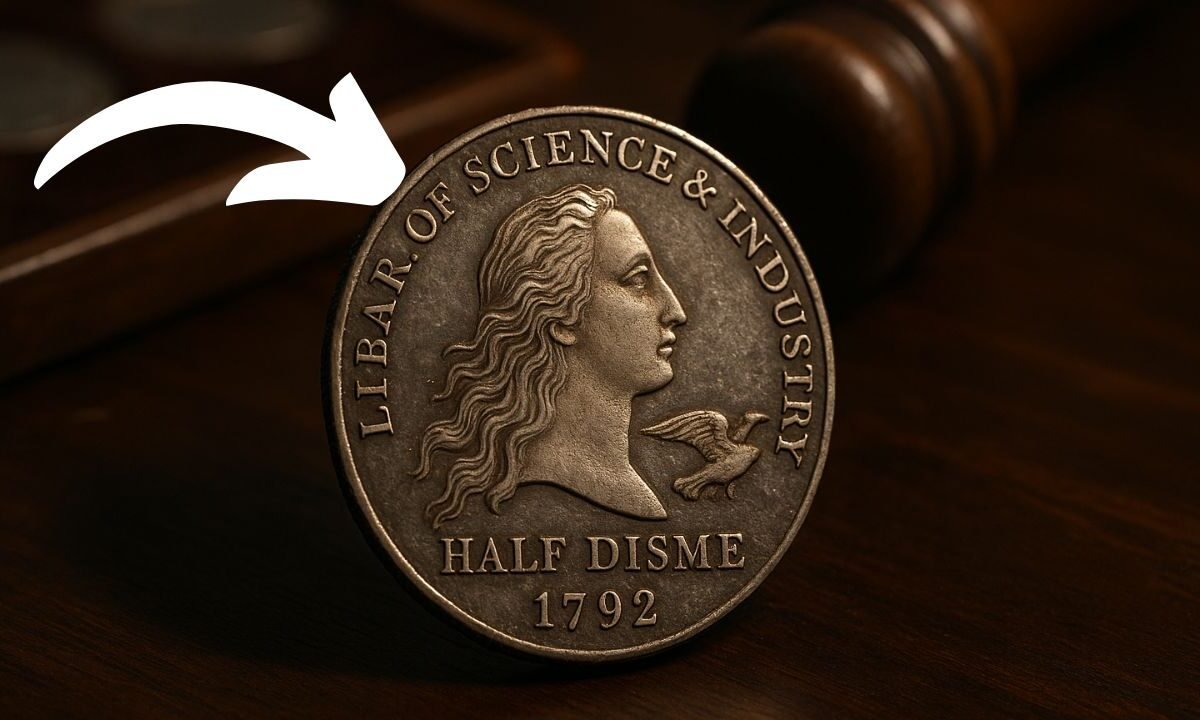The 1792 Half Disme (pronounced “deem”) is widely recognized as the first U.S. federal coin struck under the new nation’s authority.
Produced in July 1792—before the Philadelphia Mint building was fully operational—these small silver pieces were created to solve an urgent need for small change in everyday commerce.
Backed by the Coinage Act of 1792, the Half Disme became a tangible symbol of the United States’ early commitment to a unified monetary system and remains a cornerstone of American numismatics today.
What Is The 1792 Half Disme?
The Half Disme carried a value of five cents and is often treated by specialists as the first circulating U.S. coinage of the constitutional era.
While some debate whether it should be labeled a regular issue or a pattern, strong evidence shows that many pieces circulated, bearing honest wear from pockets and tills.
That real-world use anchors its reputation as the coin that kick-started America’s minting legacy.
How And Where It Was Struck
Because the Mint wasn’t yet ready, the Half Dismes were produced at John Harper’s private workshop in Philadelphia.
Historical notes tie Thomas Jefferson closely to the operation, including the delivery and disbursement of newly struck coins, which likely entered everyday transactions.
This improvisational start—outside the official Mint building—highlights the nation’s determination to put federal coinage into the hands of citizens quickly.
Specifications And Design
The coin is tiny but packed with symbolism.
The obverse shows Liberty facing left with the motto “LIB. PAR. OF SCIENCE & INDUSTRY”, a nod to Enlightenment ideals and national progress.
The reverse features a small eagle in flight with “UNI. STATES OF AMERICA” and the denomination “HALF DISME.”
Typical technical specs are a silver-copper alloy (about .892 fine silver), weight ~1.35 g, diameter ~17.5 mm, and a reeded edge.
Attribution is often given to early designers such as Robert Birch or Joseph Wright.
Mintage, Survival, And Rarity
Most authorities cite an approximate mintage of 1,500 pieces, with some estimates extending as high as 2,000–2,500.
Surviving examples are scarce—commonly estimated in the low hundreds—and are avidly pursued by collectors.
Because many were spent in commerce, true Mint State pieces are exceptionally rare, while problem-free circulated examples also command strong premiums due to intense historical interest.
Quick Specs And Market Snapshot
| Attribute | Details |
|---|---|
| Denomination | Half Disme (Five Cents) |
| Year | 1792 |
| Authority | Coinage Act of 1792 |
| Striking Location | Philadelphia (John Harper’s shop; pre-Mint building) |
| Composition | ~89.2% silver, balance copper |
| Weight | ~1.35 g (≈20.8 grains) |
| Diameter | ~17.5 mm |
| Edge | Reeded |
| Legends | Obv: LIB. PAR. OF SCIENCE & INDUSTRY; Rev: UNI. STATES OF AMERICA / HALF DISME |
| Estimated Mintage | ~1,500 (some estimates up to 2,000–2,500) |
| Survivors | Few hundred (all grades combined) |
| Value Drivers | Grade, eye appeal, originality, provenance; finest examples reach six–seven figures |
Why The Name Says “Disme”
The word “Disme” reflects French/Latin roots for “tenth” (from dix/decimus). Early U.S. coinage adopted this spelling, which later evolved to “dime.”
The traditional pronunciation—“deem”—is still referenced by numismatists and explains the modern word’s sound despite the spelling change.
Collecting Tips And Value Factors
Market interest remains strong because the 1792 Half Disme represents a first-of-its-kind federal issue. Collectors should weigh:
- Authenticity and certification: Early federal coins are targets for counterfeits; third-party grading is essential.
- Surface originality: Untampered surfaces with natural patina are prized.
- Strike and eye appeal: Early planchet and strike quirks are normal; coins with attractive toning and fewer marks bring premiums.
- Provenance: A well-documented ownership trail can notably boost value.
From an improvised workshop in Philadelphia to the pockets of early Americans, the 1792 Half Disme embodies the nation’s first confident step toward a unified currency.
Its blend of history, scarcity, and symbolism keeps it at the top of many want lists.
Whether you view it as a circulating issue or a transitional pattern, the Half Disme’s story—rooted in the Coinage Act of 1792, early American craftsmanship, and genuine circulation—makes it one of the most compelling coins in U.S. history.
FAQs
Is The 1792 Half Disme Considered A Regular Issue Or A Pattern?
Collectors debate this point. Because many examples saw circulation, a strong case exists for treating it as a regular issue, even though it was struck outside the official Mint building.
How Rare Is It Today?
Only a few hundred pieces are believed to survive in all grades. Mint State examples are extremely rare and command the highest prices.
What Features Impact Its Value The Most?
Grade, eye appeal, surface originality, and provenance are key. Coins with attractive toning and minimal problems often sell for exceptional premiums.

